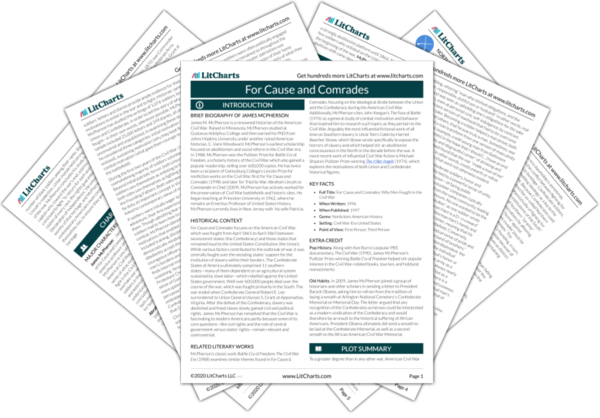Summary
Analysis
The uncensored letters and diaries of Civil War soldiers “provide fuller and more candid explanations for their decisions to enlist and fight” than exist for soldiers in any other war. Between the Union and the Confederate Armies, three million soldiers fought in the Civil War. It's impossible to get a fully representative sample of these soldiers, but James McPherson does the next best thing: selecting a “quasi-representative sample” of the surviving documents and reading them with an eye toward answering certain questions.
The American Civil War was fought between 1861 and 1865, between the predominantly Northern states which remained loyal to the Union and the Southern states which seceded to form the Confederacy. James McPherson, an American historian whose scholarly focus has been the Civil War era, introduces the present project: to understand what made soldiers on both sides enlist and fight.
Themes
McPherson’s sample consists of 1,076 soldiers: 647 Union and 429 Confederate. The number of Confederate soldiers is an overrepresentation—Confederates made up 29 percent of the total number of soldiers in reality, while here, they make up 40 percent of the studied soldiers—but this allows McPherson to “broaden the base for generalizations” about these soldiers.
McPherson lays the groundwork for his project by explaining his selection of sources. Any researcher must be conscientious about the sources that will provide the basis for his conclusions. In this case, McPherson wants to broadly reflect the historical proportion of Union and Confederate soldiers but also to avoid being overly broad in his conclusions about the smaller Confederate sample.
Themes
When considering soldiers’ ages, marital status, geographical distribution, and branch of service (infantry, cavalry, artillery, and navy), the studied samples are fairly representative. By definition, however, the 10-12 percent of soldiers who were illiterate are not represented. Black Union soldiers are also underrepresented, as are foreign-born soldiers, unskilled laborers, and nonslaveholding farmers (in the Confederate sample). The samples are also biased toward officers and those who volunteered near the start of the war.
By choosing to focus on soldiers’ own writings, McPherson inevitably faces certain limitations, particularly when dealing with those populations whose literacy rates were lower. This leads to certain under- and overrepresentations. For instance, about one-third of Confederate soldiers belonged to slaveholding families, compared to two-thirds of McPherson’s sample (of those whose slaveholding status can be determined).
Themes
McPherson explains that the sample’s bias toward native-born, middle- and upper-class, early enlistees is unavoidable. This is because these soldiers were more likely to write letters and diaries, and their descendants more likely to preserve them, than “working-class, foreign-born, black, or slaveless soldiers.” But this limitation actually yields certain advantages. McPherson is most interested in the motives of soldiers who did most of the fighting, and casualty figures suggest that the groups which are overrepresented in the sample are indeed those who did a disproportionate amount of fighting.
McPherson explains the trade-offs entailed by his selection of data. In short, while certain groups are favored, the available data is also skewed in favor of those soldiers who were most involved in combat, which provides more of a basis for understanding the motives of the heaviest fighters. The greater availability of data for such soldiers might be due to the fact that the families of soldiers who were killed in action were more likely to preserve their letters and diaries.
Themes
Get the entire For Cause and Comrades LitChart as a printable PDF.

McPherson states that he tells the story of why these men fought through their own words as much as possible. Their words represent the “tip of the iceberg”—for every statement McPherson quotes, at least six more such statements appear in his notes. Although he identifies the occasional famous soldier by name, most are identified in the text by their rank, regiment, state, and branch of service (typically infantry, unless otherwise noted). He also refrains from correcting most of the soldiers’ “delightfully original and creative” spelling.
While no single soldier’s perspective should be taken as representative of the whole of the group they’re a part of, the soldiers whom McPherson chooses to quote do represent a significant number of like-minded counterparts who aren’t quoted. Additionally, McPherson tries to stick close to the language of the soldiers themselves, likely to retain the authenticity of the soldiers’ words and experiences.
Themes












